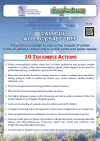Urban air pollution and climate change: "The Decalogue: Allergy Safe Tree" for allergic and respiratory diseases care
- PMID: 30214380
- PMCID: PMC6134633
- DOI: 10.1186/s12948-018-0098-3
Urban air pollution and climate change: "The Decalogue: Allergy Safe Tree" for allergic and respiratory diseases care
Abstract
Background: According to the World Health Organization, air pollution is closely associated with climate change and, in particular, with global warming. In addition to melting of ice and snow, rising sea level, and flooding of coastal areas, global warming is leading to a tropicalization of temperate marine ecosystems. Moreover, the effects of air pollution on airway and lung diseases are well documented as reported by the World Allergy Organization.
Methods: Scientific literature was searched for studies investigating the effect of the interaction between air pollution and climate change on allergic and respiratory diseases.
Results: Since 1990s, a multitude of articles and reviews have been published on this topic, with many studies confirming that the warming of our planet is caused by the "greenhouse effect" as a result of increased emission of "greenhouse" gases. Air pollution is also closely linked to global warming: the emission of hydrocarbon combustion products leads to increased concentrations of biological allergens such as pollens, generating a mixture of these particles called particulate matter (PM). The concept is that global warming is linked to the emission of hydrocarbon combustion products, since both carbon dioxide and heat increase pollen emission into the atmosphere, and all these particles make up PM10. However, the understanding of the mechanisms by which PM affects human health is still limited. Therefore, several studies are trying to determine the causes of global warming. There is also evidence that increased concentrations of air pollutants and pollens can activate inflammatory mediators in the airways. Our Task Force has prepared a Decalogue of rules addressing public administrators, which aims to limit the amount of allergenic pollen in the air without sacrificing public green areas.
Conclusions: Several studies underscore the significant risks of global warming on human health due to increasing levels of air pollution. The impact of climate change on respiratory diseases appears well documented. The last decades have seen a rise in the concentrations of pollens and pollutants in the air. This rise parallels the increase in the number of people presenting with allergic symptoms (e.g., allergic rhinitis, conjunctivitis, and asthma), who often require emergency medical care. Our hope is that scientists from different disciplines will work together with institutions, pharmaceutical companies and lay organizations to limit the adverse health effects of air pollution and global warming.
Figures
References
-
- World Health Organization: WHO. Air quality guidelines for particulate matter, ozone, nitrogen dioxide and sulphur dioxide. Global Update 2005. In summary of risk assessment. http://apps.who.int/iris/bitstream/handle/10665/69477/WHO_SDE_PHE_OEH_06....
-
- European Environment Agency (EEA) report. EEA Report No 28/2016. https://www.eea.europa.eu/data-and-maps/figures/percentage-of-the-eu-urban.
-
- US Environmental Protection Agency: National ambient air quality standards (NAAQS). http://www.epa.gov/air/criteria.html.
-
- D’Amato G, Holgate ST, Pawankar R, Ledford DK, Cecchi L, Al-Ahmad M, Al-Enezi F, Al-Muhsen S, Ansotegui I, Baena-Cagnani CE, Baker DJ, Bayram H, Bergmann KC, Boulet LP, Buters JT, D’Amato M, Dorsano S, Douwes J, Finlay SE, Garrasi D, Gómez M, Haahtela T, Halwani R, Hassani Y, Mahboub B, Marks G, Michelozzi P, Montagni M, Nunes C, Oh JJ, Popov TA, Portnoy J, Ridolo E, Rosário N, Rottem M, Sánchez-Borges M, Sibanda E, Sienra-Monge JJ, Vitale C, Annesi-Maesano Meteorological conditions, climate change, new emerging factors, and asthma and related allergic disorders. A statement of the World Allergy Organization. World Allergy Organ J. 2015;8(1):1–52. doi: 10.1186/s40413-015-0073-0. - DOI - PMC - PubMed
-
- de Hartog JJ, Hoek G, Mirme A, Tuch T, Kos GP, ten Brink HM, Brunekreef B, Cyrys J, Heinrich J, Pitz M, Lanki T, Vallius M, Pekkanen J, Kreyling WG. Relationship between different size classes of particulate matter and meteorology in three European cities. J Environ Monit. 2005;7:302–310. doi: 10.1039/b415153d. - DOI - PubMed
Publication types
LinkOut - more resources
Full Text Sources
Other Literature Sources


